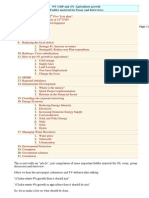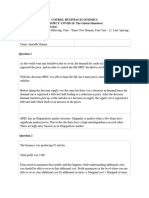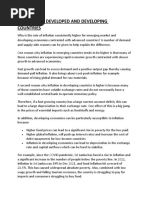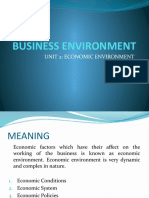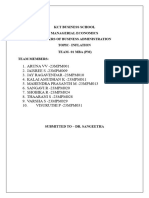Project
Uploaded by
Ankit MundraProject
Uploaded by
Ankit MundraQ5)Comment on the causes and consequences of Indias high inflation rate over the years.
Comments on its solution Reason 1)increase in money in public Incomes rising: The per capita incomes have risen in the 2000s decade tracking rise in GDP and lower population growth , whereas we see decline in food production in the same period. The strong growth is likely to continue and would continue to contribute to higher incomes and demand. 2)Employment Due to increase in employment demand has been increased and this has reflected in increase in inflation 3)Bank Policies Easy policies of banks on loans has increased money in public and this has caused raise inflation
4)Population increase Due to high growth of population , supply is not been able to fulfill the demand in due to this inflation has increased 5)Hoarding
consequences 1. People start consuming or buying less of these goods and services as their income is limited. This leads to slowdown not only in consumption but also production. This is because manufactures will produce fewer goods due to high costs and anticipated lower demand. 2. Banks will increase interest rates as inflation increases otherwise real interest rate will be negative. (Real interest ~ Nominal interest rate inflation). This makes borrowing costly for both consumers and corporate. Thus people will buy fewer automobiles, houses and other goods. Industries will not borrow money from banks to invest in capacity expansion because borrowing rates are high. 3. Higher interest rates lead to slowdown in the economy. This leads to increase in unemployment because companies start focusing on cost cutting and reduces hiring. Remember Jet Airways lay off over 1000 employees to save cost. 4. Rising inflation can prompt trade unions to demand higher wages, to keep up with consumer prices. Rising wages in turn can help fuel inflation. 5. Inflation affects the productivity of companies. They add inefficiencies in the market, and make it difficult for companies to budget or plan long-term. Solution Monetary Policy The most important and commonly used method is monetary policy. Most central banks use high interest rates and slow growth of the money supply as the traditional ways to fight or prevent inflation. RBI raised CRR, Repo rate and Reverse repo rate to reduce money supply in the economy to fight inflation which was hovering in double digit. High interest rates make borrowing expensive and hence, people as well as corporate borrow less money from banks. This reduced the demand for goods and services such as real estate, automobiles and others.
Fixed Interest Rate As we know high inflation reduced the value of money. A number of smaller countries who do not have sophisticated banking system rely on tying their currency with that of a developed country. Under a fixed exchange rate currency regime, a countrysinglequotes currency is tied in value to another single currency or to a basket of other currencies (or sometimes to another measure of value, such as gold). A fixed exchange rate is usually used to stabilize the value of a currency, vis--vis the currency it is pegged to. Government Measures Apart from these two broad methods, government takes some protectionist measures as well to fight inflation. Government may ban export of essential items such as pulses, cereals and oils to support the domestic consumption and hence reduced their prices. Also, government may lower duties on the import of similar items which are having less supply in the economy
Q6)Calculate the foods inflation rate in India since 1990-91 to till date. Recently India is having high food inflation rate. Discuss the cause, consequence and solution of it
CAUSES 1)Agriculture Sector Decadal Performance The growth rates in the production of key food-grains in India have declined with each passing decade. Average growth in foodgrain production was highest in 1950s and declined in subsequent decades. It briefly improved in the 1990s and reached its lowest in the subsequent decade, when the growth rate in incomes was at its highest pace. Within foodgrains, rice and wheat both recorded average growth rates lower than 1%. Growth rate in pulses was higher in the 2000s decade but has not been enough to keep pace with the changing demand pattern of the Indian population. Another significant feature is the volatility in growth rates which has increased in 1990s and 2000s. 2) Investment in agriculture has declined: In the 1950s, investment in agriculture was 19% of total investments and has declined steadily to touch 8.5% in the 2000s . The growth rate of investments in agriculture has declined in 2000s when total investment in the economy has increased. 3) Dependence on monsoon: Monsoons have always played an important role in Indian economy. With economic growth and improvement in technology we should see a decline in our dependence on the monsoons. However, the dependence on monsoons remains as strong as ever CONSEQANCE a persistent rise in food prices could lead employees to demand higher wages. As food still forms a large percentage of household expenditure for majority of India households, employers might be left with little choice than to raise wages. The higher wages then leads to further rise in demand and again rise in prices. It becomes a classic case of cost-push inflation becoming demand-pull inflation. SOLUTION The investment levels have to be increased. Private sector has to be invited to increase its investment in various agriculture and related activities and there is a need to consolidate and raise farm sizes. From a more micro perspective, there is a need to overhaul the entire supply chain of foodgrain management by the government. shortcomings in all three aspects of food management production, procurement and distribution. All these are long-term issues and cannot be resolved overnight
Q7/8) Briefly, comment on the various fiscal measures implemented by central government to control inflation since 1980-81 to till date.
The most important and commonly used method is monetary policy. Most central banks use high interest rates and slow growth of the money supply as the traditional ways to fight or prevent inflation. RBI raised CRR, Repo rate and Reverse repo rate to reduce money supply in the economy to fight inflation which was hovering in double digit. High interest rates make borrowing expensive and hence, people as well as corporate borrow less money from banks. This reduced the demand for goods and services such as real estate, automobiles and others The government has been slow to wake up to the enormity of the problem and the decline in agriculture sector has not been a focal point of attention. It was seen as a normal transition of an agrarian economy to more productive sectors of an economy. In other economies, similar transition did not mean agriculture production not keeping pace with rising population and incomes. It simply means agriculture became more productive with lesser share of workforce needed to produce the increased output. The Planning Commission was one of the first bodies to see this decline in agriculture. In eleventh plan it proposed to raise agriculture growth to 4% but so far it has been just around 2.2% in its first three years of the eleventh plan (2007-10). Around 7% growth is needed in next two years of the plan. Seeing this as difficult, Planning Commission said around 3% growth was likely in its mid-term evaluation of the Eleventh Plan. The lower growth rate is again disappointing and much more needs to be done. In the Union Budget for 2010-11 the Finance Minister proposed to extend the green revolution to the eastern region of the country comprising Bihar, Chattisgarh, Jharkhand, Eastern UP, West Bengal and Orissa, with the active involvement of Gram Sabhas and the farming families. He also proposed to organise 60,000 "pulses and oil seed villages" in rain-fed areas during 2010-11 and provide an integrated intervention for water harvesting, watershed management and soil health, to enhance the productivity of the dry land farming areas
Q9)
Briefly justify your answer that whether inflation rate in Indian is a monetary or fiscal phenomena or any thing else over the years.
The phenomenon inflation is a result of monetary policy Fiscal policy and various other reasons like 1)Living Standard 2)Change in behavior 3)Cartelization and Hoarding
You might also like
- Current Affairs Assignment: Name: Satyajit Bhandare 33242, MBA 1 (HR) SIBM, PuneNo ratings yetCurrent Affairs Assignment: Name: Satyajit Bhandare 33242, MBA 1 (HR) SIBM, Pune7 pages
- College of Engineering and Management, Kolaghat: Topic: Causes of Inflation and Effects of InflationNo ratings yetCollege of Engineering and Management, Kolaghat: Topic: Causes of Inflation and Effects of Inflation11 pages
- Amity International Business School: Assignment OnNo ratings yetAmity International Business School: Assignment On12 pages
- Macroeconomic Problems of India Economy Project77% (52)Macroeconomic Problems of India Economy Project4 pages
- Indian Economy and Policy Assignment:1: Doon Business School Selaqui, DehradunNo ratings yetIndian Economy and Policy Assignment:1: Doon Business School Selaqui, Dehradun8 pages
- Unit 3 Economic Environment: o o o o o o o o o oNo ratings yetUnit 3 Economic Environment: o o o o o o o o o o7 pages
- The Indian Economy: Dealing With InflationNo ratings yetThe Indian Economy: Dealing With Inflation3 pages
- (10 Marks) Ans:: Economy Mains Questions 2023No ratings yet(10 Marks) Ans:: Economy Mains Questions 202326 pages
- Micro-Foundations of Macroeconomic Development: Nclusive Rowth AND NflationNo ratings yetMicro-Foundations of Macroeconomic Development: Nclusive Rowth AND Nflation19 pages
- Microeconomics Project: Subsidies in India: Is A Case For Failure of Government Intervention?No ratings yetMicroeconomics Project: Subsidies in India: Is A Case For Failure of Government Intervention?17 pages
- Inflation in Developed and Developing CountriesNo ratings yetInflation in Developed and Developing Countries8 pages
- Deepak Mohanty: Executive Director, Reserve Bank of India: Inflation DynamicsNo ratings yetDeepak Mohanty: Executive Director, Reserve Bank of India: Inflation Dynamics4 pages
- Impact of Economic Reforms On Different Sectors of Indian EconomyNo ratings yetImpact of Economic Reforms On Different Sectors of Indian Economy15 pages
- Iasbaba'S Daily Current Affairs - 26Th July, 2016: ArchivesNo ratings yetIasbaba'S Daily Current Affairs - 26Th July, 2016: Archives8 pages
- Descriptive_Model_Q___A_lyst1720613162717No ratings yetDescriptive_Model_Q___A_lyst172061316271714 pages
- IE 2 - Unit 1 - Macroeconomic Scenario and Policy Options - Manoj PandaNo ratings yetIE 2 - Unit 1 - Macroeconomic Scenario and Policy Options - Manoj Panda35 pages
- Economics - II Project - Sumant Meena (217055) & Himanshu Cheeta (217089)No ratings yetEconomics - II Project - Sumant Meena (217055) & Himanshu Cheeta (217089)31 pages
- Ashley Notes Business Education Form Four Business NotesNo ratings yetAshley Notes Business Education Form Four Business Notes76 pages
- Ausgust-Secure-GS3-Synopsis-CompilationNo ratings yetAusgust-Secure-GS3-Synopsis-Compilation75 pages
- Inflation Impact On Indian Economy AgricultureNo ratings yetInflation Impact On Indian Economy Agriculture4 pages
- Budget Speech by Finance Minister On 28 February, 2011No ratings yetBudget Speech by Finance Minister On 28 February, 201135 pages
- UPSC Civil Services Examination: UPSC Notes (GS-III) Topic: Inflation - UPSC Economy NotesNo ratings yetUPSC Civil Services Examination: UPSC Notes (GS-III) Topic: Inflation - UPSC Economy Notes4 pages
- Bangladesh Quarterly Economic Update: September 2014From EverandBangladesh Quarterly Economic Update: September 2014No ratings yet
- Capstone Stem12d 2018 2019 Tublic Pesticide100% (2)Capstone Stem12d 2018 2019 Tublic Pesticide78 pages
- Aztec Chicken With Sweet Potato-Corn Mash RecipeNo ratings yetAztec Chicken With Sweet Potato-Corn Mash Recipe2 pages
- Week Commencing 17th March 2014: Wear Something Red!No ratings yetWeek Commencing 17th March 2014: Wear Something Red!2 pages
- General Agriculture JRF Questions Compiled86% (14)General Agriculture JRF Questions Compiled45 pages
- Carnivores Herbivores and Omnivores PowerPointNo ratings yetCarnivores Herbivores and Omnivores PowerPoint30 pages
- Language Nouns Quiz 1 I. Write The Plural Form of The NounNo ratings yetLanguage Nouns Quiz 1 I. Write The Plural Form of The Noun2 pages
- The Girl I Left Behind - Endō, Shūsaku, 1923-1996 Williams, Mark - 1995 - New York - New Directions - 9780811213035 - Anna's ArchiveNo ratings yetThe Girl I Left Behind - Endō, Shūsaku, 1923-1996 Williams, Mark - 1995 - New York - New Directions - 9780811213035 - Anna's Archive200 pages
- Moroccan Lentil Soup: A Friesen-Thorpe FavouriteNo ratings yetMoroccan Lentil Soup: A Friesen-Thorpe Favourite1 page
- Production Bissap Hibiscus Sabdariffa Au Senegal PDFNo ratings yetProduction Bissap Hibiscus Sabdariffa Au Senegal PDF14 pages
- Fairfield by Marriott Belagavi 30-01-2019No ratings yetFairfield by Marriott Belagavi 30-01-20194 pages
- Chain-of-Production-of-Chocolate and CakeNo ratings yetChain-of-Production-of-Chocolate and Cake14 pages
- Current Affairs Assignment: Name: Satyajit Bhandare 33242, MBA 1 (HR) SIBM, PuneCurrent Affairs Assignment: Name: Satyajit Bhandare 33242, MBA 1 (HR) SIBM, Pune
- College of Engineering and Management, Kolaghat: Topic: Causes of Inflation and Effects of InflationCollege of Engineering and Management, Kolaghat: Topic: Causes of Inflation and Effects of Inflation
- Amity International Business School: Assignment OnAmity International Business School: Assignment On
- Indian Economy and Policy Assignment:1: Doon Business School Selaqui, DehradunIndian Economy and Policy Assignment:1: Doon Business School Selaqui, Dehradun
- Micro-Foundations of Macroeconomic Development: Nclusive Rowth AND NflationMicro-Foundations of Macroeconomic Development: Nclusive Rowth AND Nflation
- Microeconomics Project: Subsidies in India: Is A Case For Failure of Government Intervention?Microeconomics Project: Subsidies in India: Is A Case For Failure of Government Intervention?
- Deepak Mohanty: Executive Director, Reserve Bank of India: Inflation DynamicsDeepak Mohanty: Executive Director, Reserve Bank of India: Inflation Dynamics
- Impact of Economic Reforms On Different Sectors of Indian EconomyImpact of Economic Reforms On Different Sectors of Indian Economy
- Iasbaba'S Daily Current Affairs - 26Th July, 2016: ArchivesIasbaba'S Daily Current Affairs - 26Th July, 2016: Archives
- IE 2 - Unit 1 - Macroeconomic Scenario and Policy Options - Manoj PandaIE 2 - Unit 1 - Macroeconomic Scenario and Policy Options - Manoj Panda
- Economics - II Project - Sumant Meena (217055) & Himanshu Cheeta (217089)Economics - II Project - Sumant Meena (217055) & Himanshu Cheeta (217089)
- Ashley Notes Business Education Form Four Business NotesAshley Notes Business Education Form Four Business Notes
- Budget Speech by Finance Minister On 28 February, 2011Budget Speech by Finance Minister On 28 February, 2011
- UPSC Civil Services Examination: UPSC Notes (GS-III) Topic: Inflation - UPSC Economy NotesUPSC Civil Services Examination: UPSC Notes (GS-III) Topic: Inflation - UPSC Economy Notes
- Bangladesh Quarterly Economic Update: September 2014From EverandBangladesh Quarterly Economic Update: September 2014
- Week Commencing 17th March 2014: Wear Something Red!Week Commencing 17th March 2014: Wear Something Red!
- Language Nouns Quiz 1 I. Write The Plural Form of The NounLanguage Nouns Quiz 1 I. Write The Plural Form of The Noun
- The Girl I Left Behind - Endō, Shūsaku, 1923-1996 Williams, Mark - 1995 - New York - New Directions - 9780811213035 - Anna's ArchiveThe Girl I Left Behind - Endō, Shūsaku, 1923-1996 Williams, Mark - 1995 - New York - New Directions - 9780811213035 - Anna's Archive
- Production Bissap Hibiscus Sabdariffa Au Senegal PDFProduction Bissap Hibiscus Sabdariffa Au Senegal PDF













